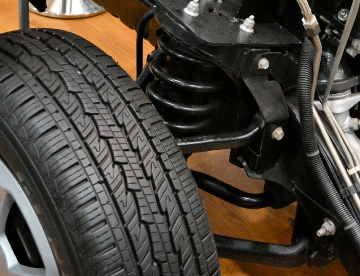Suspension and front end repair shop in Florida.
Suspension and Front end work
The springs and related parts intermediate between the wheels and the frame, subframe, or side rails of a unitized body. The suspension supports the weight of the upper part of a vehicle on its axles and wheels, allows the vehicle to travel over irregular surfaces with a minimum of up-and-down body movement, and allows the vehicle to corner with minimum roll or loss of traction between the tires and the road. In a typical suspension system for a vehicle with front-engine and front-wheel drive (see illustration), the weight of the vehicle applies an initial compression to the coil springs. When the tires and wheels encounter irregularities in the road, the springs further compress or expand to absorb most of the shock. The suspension at the rear wheels is usually simpler than for the front wheels, which require multiple-point attachments so the wheels can move up and down while swinging from side to side for steering.
A telescoping hydraulic damper, known as a shock absorber, is mounted separately or in the strut at each wheel to restrain spring movement and prevent prolonged spring oscillations. The shock absorber contains a piston that moves in a cylinder as the wheel moves up and down with respect to the vehicle body or frame. As the piston moves, it forces a fluid through an orifice, imposing a restraint on the spring. Spring-loaded valves open to permit quicker flow of the fluid if fluid pressure rises high enough, as it may when rapid wheel movements take place. Most automotive vehicles use gas-filled shock absorbers in which the air space above the fluid is filled with a pressurized gas such as nitrogen. The gas pressure on the fluid reduces the creation of air bubbles and foaming.
Most automotive vehicles have independent front suspension, usually using coil springs as part of either a short-arm long-arm or a MacPherson-strut suspension system. A MacPherson-strut suspension (see illustration) combines a coil spring and shock absorber into a strut assembly that requires only a beam-type lower control arm. Some vehicles with short-arm long-arm front suspension use either longitudinal or transverse torsion bars for the front springs. One end of the torsion bar is attached to the lower control arm, and the other end is anchored to the vehicle body or frame. As the tire and wheel move up and down, the torsion bar provides springing action by twisting about its long axis. Turning an adjustment bolt at one end of the torsion bar raises or lowers the vehicle RIDe height.
Most automobiles and many light trucks have coil springs at the rear. These may mount on the rear drive axle, on struts, or on various types of control or suspension arms in an independent suspension system. Some rear-drive vehicles have leaf springs at the rear. Others use transverse torsion bars.
Come on down to West Florida’s full service auto repair shop for all your auto suspensionand front end needs.
